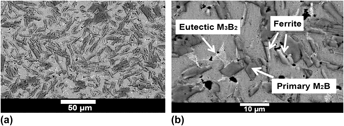Crossref Citations
This article has been cited by the following publications. This list is generated based on data provided by
Crossref.
Ran, Cui
Yanhai, Cheng
Xianliang, Meng
Shizhe, Feng
and
Zhengtong, Han
2018.
Microstructure and properties of heat treated 1Cr17Ni4MoB steel fabricated by laser melting deposition.
Optics & Laser Technology,
Vol. 108,
Issue. ,
p.
59.
Koga, Guilherme Y.
Otani, Lucas B.
Silva, Ana M. B.
Roche, Virginie
Nogueira, Ricardo P.
Jorge, Alberto M.
Bolfarini, Claudemiro
Kiminami, Claudio S.
and
Botta, Walter J.
2018.
Characterization and Corrosion Resistance of Boron-Containing-Austenitic Stainless Steels Produced by Rapid Solidification Techniques.
Materials,
Vol. 11,
Issue. 11,
p.
2189.
Soyama, Juliano
Lopes, Thiago Pama
Zepon, Guilherme
Kiminami, Claudio Shyinti
Botta, Walter José
and
Bolfarini, Claudemiro
2019.
Wear Resistant Duplex Stainless Steels Produced by Spray Forming.
Metals and Materials International,
Vol. 25,
Issue. 2,
p.
456.
Koga, G. Y.
Zepon, G.
Santos, L. S.
Bolfarini, C.
Kiminami, C. S.
and
Botta, W. J.
2019.
Wear Resistance of Boron-Modified Supermartensitic Stainless Steel Coatings Produced by High-Velocity Oxygen Fuel Process.
Journal of Thermal Spray Technology,
Vol. 28,
Issue. 8,
p.
2003.
Freitas, Brenda Juliet Martins
de Oliveira, Vinicius Antonio
Gargarella, Piter
Koga, Guilherme Yuuki
and
Bolfarini, Claudemiro
2021.
Microstructural characterization and wear resistance of boride-reinforced steel coatings produced by Selective Laser Melting (SLM).
Surface and Coatings Technology,
Vol. 426,
Issue. ,
p.
127779.
dos Santos, E. R.
da Silva, W. A.
Koga, G. Y.
Bolfarini, C.
and
Zepon, G.
2021.
Corrosion Resistant Boron-Modified Ferritic and Austenitic Stainless Steels Designed by CALPHAD.
Metallurgical and Materials Transactions A,
Vol. 52,
Issue. 7,
p.
2708.
Wang, Hui
and
Wang, Tao
2021.
Study on 2.0 wt.% B Dual-Phase Stainless Steels of Different Ferrite/Austenite Ratios.
Journal of Materials Engineering and Performance,
Vol. 30,
Issue. 2,
p.
1340.
Bushueva, Evdokiya
Turlo, Evgeniy
Kladieva, Evgeniya
Sulyaeva, Veronica
and
Pukhova, Elizaveta
2022.
Influence of alloying (Cr, Fe, Ni) on the corrosion resistance of layers formed by electron-beam processing.
Chimica Techno Acta,
Vol. 9,
Issue. 3,
Koga, Guilherme Yuuki
Bolfarini, Claudemiro
Kiminami, Claudio Shyinti
Jorge, Alberto Moreira
and
Botta, Walter José
2022.
An Overview of Thermally Sprayed Fe-Cr-Nb-B Metallic Glass Coatings: From the Alloy Development to the Coating’s Performance Against Corrosion and Wear.
Journal of Thermal Spray Technology,
Vol. 31,
Issue. 4,
p.
923.
Silva, David D.S.
Nascimento, Alexandre R.C.
Koga, Guilherme Y.
Zepon, Guilherme
Kiminami, Claudio S.
Botta, Walter J.
and
Bolfarini, Claudemiro
2023.
Alloy design for microstructural-tailored boron-modified ferritic stainless steel to ensure corrosion and wear resistance.
Journal of Materials Research and Technology,
Vol. 24,
Issue. ,
p.
418.
Bushueva, E. G.
Drobyaz, E. A.
Golkovsky, M. G.
Bataev, V. A.
Domarov, E. V.
and
Dudareva, A. A.
2023.
Structure and Abrasive Wear Resistance of Stainless-Steel Surface Layers Alloyed with Boron.
Journal of Friction and Wear,
Vol. 44,
Issue. 6,
p.
354.
Martins Freitas, Brenda Juliet
Yuuki Koga, Guilherme
Miguel Rodrigues, Luana Cristina
Botta Filho, Walter José
de Traglia Amancio-Filho, Sergio
and
Bolfarini, Claudemiro
2024.
Ultrafine-grained stainless steel with wear-resistant nanoborides decorating grain boundaries produced by laser powder bed fusion.
Materialia,
Vol. 34,
Issue. ,
p.
102079.
Batalha, Weverson C.
Jorge Junior, Alberto M.
Mantel, Marc
Champion, Yannick
and
Roche, Virginie
2024.
The study of passive film's resistivity distribution to crystalline Fe-based pseudo high entropy alloys: The use of measurement model and Cole-Cole regression.
Corrosion Science,
Vol. 230,
Issue. ,
p.
111905.
Sukhova, O. V.
2024.
Effect of Structure and Cooling Rate on Mechanical Properties and Wear Resistance of Fe–В–С Alloys.
METALLOFIZIKA I NOVEISHIE TEKHNOLOGII,
Vol. 45,
Issue. 11,
p.
1337.
Freitas, Brenda Juliet Martins
Koga, Guilherme Yuuki
de Traglia Amancio-Filho, Sergio
and
Bolfarini, Claudemiro
2024.
Corrosion-resistant and ultrafine-grained boron-containing stainless steel produced by laser powder bed fusion.
Corrosion Science,
Vol. 235,
Issue. ,
p.
112206.
Martins Freitas, Brenda Juliet
Yuuki Koga, Guilherme
Arneitz, Siegfried
Bolfarini, Claudemiro
and
de Traglia Amancio-Filho, Sergio
2024.
Optimizing LPBF-parameters by Box-Behnken design for printing crack-free and dense high-boron alloyed stainless steel parts.
Additive Manufacturing Letters,
Vol. 9,
Issue. ,
p.
100206.
